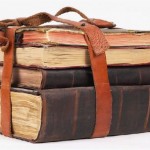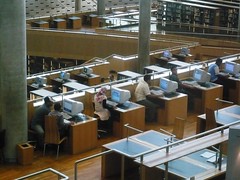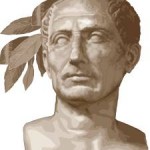 One of the ubiquitous icons of education is the textbook. It symbolizes the presence of consistent, reliable knowledge, which has led to creation of metaphors like “‘it was a textbook takeoff’ and ‘it was all done by the textbook’ (Crawford, 2006). At the present time when many innovative educators are contemplating replacing paper textbooks with an electronic version, it is hard for some to fathom education without paper textbooks.
One of the ubiquitous icons of education is the textbook. It symbolizes the presence of consistent, reliable knowledge, which has led to creation of metaphors like “‘it was a textbook takeoff’ and ‘it was all done by the textbook’ (Crawford, 2006). At the present time when many innovative educators are contemplating replacing paper textbooks with an electronic version, it is hard for some to fathom education without paper textbooks.
However, there was a time when there were actually no textbooks used in education. In the world of orality, education was presumably unstructured and acquired through daily interaction and apprenticeship. The implications for education changed when the society evolved into literacy. Not being a natural skill, it became essential to acquire it formally. Initially this process restricted literacy to a limited few but many innovations allowed for it to spread to the masses. One such innovation, designed to lead people into literacy, was the textbook (Wakefield, 1998).
The earliest precursor to a textbook can be traced back to the monasteries where religious texts were copied on manuscript and codex. Each book was manually copied from a main text by different copyists and therefore there was often discrepancy in the text. While the book making industry became very organized with the rise of universities in the 13th century and many books were copied, these books cannot be classified as instructional books or text books as they were reproductions of existing books, mainly religious.
A textbook has many specific features that distinguish it from other books. Since its purpose is to educate and inform, the contents in a textbook are laid out very systematically with features like headings, subheadings, pictures, captions, and labels. While such features were hard to copy accurately by hand, it was the invention of the Gutenberg’s press in the 1450’s that made books more accessible and setup the path for the creation of the textbooks. Initially only the teachers would have access to such books as resources to teach. Hence, despite such books being used in some schooling, the word textbook first appeared in the Oxford English dictionary only around the eighteenth century when such books had made their way into the hands of students and teachers (Wakefield, 1998).
Textbooks gained popularity once mass education started. In fact education became so textbook- centered that examining textbooks provide the best insights into the history of education (Svobodny, 1985). The earliest textbooks were a mixture of grammatical rules, popular sayings, and proverbs (Wakefield, 1998). These textbooks followed the Catechetical style for its layout. This is essentially a question answer setup, where the instructor asks a question and the pupil respond to it. The text was often rhythmic to accommodate the objective of rote memorization of the content. Such books worked well and were used for a long time as it filled the void created by lack of trained teachers and dearth of proper teaching equipment like blackboard, pen, ink, or paper in the schoolhouse. Such trends also probably evolved from the preexisting oral culture.
Gradually trend changed from memorization to understanding. In 1631 a Czech educator named Comenius wrote a textbook named Janua Linguarum Reserata which favoured learning information rather than grammar. He also wrote one of the first illustrated Latin textbook for children called Orbis Sensualium Pictus in 1658. The translations of this book in various languages were used for a long time all over Europe to teach children. Its English translation was called A World of Things Obvious to the Senses Drawn in Pictures. Compulsory education and the growth of schooling led to the printing of many similar textbooks for children in Europe and the Americas.
Textbooks became the primary teaching instrument for most children in the 19th century. They provided structure to the lesson, standardized teaching, and provided a syllabus for instructions (Richards, 2001). This way textbook laid the early foundations for curriculum (Svobodny, 1985). Some textbooks of historical significance in United States schooling were the 18th century New England Primer, An American Selection of Lessons in Reading and Speaking by Webster and the 19th century McGuffey Readers. Much of these readers were for read aloud and more concerned with oral reading of the text, rather than understanding them. Also one reader would cover a large area of content like grammar, spelling, reading, and religion in an attempt to provide a complete education (Svobodny, 1985). Text books in other specific content area like math, science, and socials gradually started to emerge as well.
By mid-19 century, textbooks had become a mandatory educational tool. When immigrants came from various regions to North America, the text books became the tool to develop shared characteristics among students and en-culture students from different backgrounds. (Wakefield, 1998) Religion stories gave way to themes about general moral values and noble citizenship. Textbooks were used to mold the society politically and socially. It was believed that the job of the textbooks was to ‘… tell children what their elders want them to know’ (Fitzgerald, 1979) and to ‘… represent to each generation of students a sanctioned version of human knowledge and culture’ (De Castell, 1991).
With establishing of copyright laws and compulsory education in the United States textbooks became big business. In the race for getting their book “adopted” by schools, publishers made their books more attractive by using bigger print, less content, and including illustrations, drawings, and engravings (Svobodny, 1985). They also started printing child-centred books in the 1820’s based on the philosophy of the Swiss education reformer Pestalozzi in which the complex concepts were built gradually in the text by laying out the simpler contents first. In an attempt to capture a bigger market, the publishers started printing leveled books in the 1830’s and1840’s, which revolutionized the education system. Availability of textbooks with content targeting certain age and ability groups helped in establishing grade levels at schools (Svobodny, 1985).
Running schools and printing textbooks became a more political and economic endeavor. Wakefield (1998) suggests that the pedagogical changes from rote learning to comprehension were actually instigated by the text book industry to encourage their own marketability and so is a result of commerce and not some pedagogical research.
This leads to speculations about presence of bias in textbooks and its ability for indoctrination. Crawford (2006) aptly puts it that textbooks have become a powerful tool to shape and control popular memory and so its production is influenced by political, social, and economics beliefs of the interested parties. The attempt at enculturation of immigrants and aboriginals in North America suggests that textbooks can be used easily for indoctrination. A UNESCO study (Blumberg, 2007) found that one of the biggest obstacle in achieving gender parity in education in many countries around the world was that the text books in these countries were encouraging gender bias.
Despite controversies, textbooks have continued to be a vital part of education all over the world. They no more set curriculum but attempt to follow the ones set by the educational institutions and ministries. While textbooks are bought by schools and are free for students in the elementary and secondary schools in many countries, students purchase their own textbooks at post-secondary level. This can be a very expensive for the students.
Textbooks have always attempted to evolve in their style and content with time to suit the needs of its users and to survive the competitive market. With evolving technologies, textbooks are now taking on a digital form, ensuring that they continue to guide education in the future as well.
Reference:
Blumberg, R (2007). Gender bias in textbooks: a hidden obstacle on the road
to gender equality in education. UNESCO. Retrieved on October 8, 2011
from http://unesdoc.unesco.org/images/0015/001555/155509e.pdf
Crawford, K (2006). Editorial Review. International Journal of Historical
Learning, Teaching and Research. Retrieved on October 5th, 2011 from http://www.heirnet.org/IJHLTR/journal6/Editorialrev.pdf
De Castell, S., Luke, A. & Luke, C. (1989) ‘Beyond Criticism: The
Authority of the School Textbook’, in De Castell, S., Luke, A. &
Luke, C. (Eds) (1989) Language, Authority and Criticism: Readings on
the School Textbook. London/Philadelphia, Falmer Press.
FitzGerald, F. (1979) America Revised: History Schoolbooks in the Twentieth
Century New York, Vintage Press.
Historical Thinking. (n.d.) In Wikipedia. Retrieved October 10, 2011 from
http://en.wikipedia.org/wiki/Historical_thinking
Richards, J. (n.d).The role of textbooks in a language program. Retrieved
October 10, 2011, from http://www.professorjackrichards.com/pdfs/role-
of-textbooks.pdf
Svobodny, D. (1985). Early american textbooks, 1775-1900. A catalog of the
titles held by the educational research library. Retrieved from ERIC
database. ED264601
Wakefield, J (1998). A brief history of textbooks: where have we been all
these years? Retrieved on October 05, 2011 from
http://www.eric.ed.gov/PDFS/ED419246.pdf
Wilson, S. (2002). American textbooks in the discipline of english, 1776-
1900.Retrieved from http://www.orgs.muohio.edu/anthologies/school/






The Shift from Scroll to Codex to Print
Shifts in communication mediums throughout history have affected how people interact with each other and text. This commentary will discuss how the transitions from scroll to codex to print affected reading, writing and communication. Communication remained largely oral in ancient times even when the scroll and early codex where introduced into society. Writing with the scroll and codex was very similar to the spoken word containing mnemonics, aggregation, and epithets (Ong, 2002). Readers often memorized information from these two mediums as they would memorize an oral narrative to share in public. Ong (2002) says that “writing recycled knowledge back into the oral world” (p. 117). Winger (1955) supports this view by saying that manuscripts served as a reference for storytellers. Print affected mass literacy more so than the scroll or codex because of its wide availability and ease of use. More people were able to reflect independently and take in more information as they read printed books silently (Clement, 1997).
The scroll was made up of sheets of papyrus, stitched together to form a long linear writing space that had to be unrolled during use. It must have been an awkward process to unwind the scroll at the same time as maintaining one’s place in the text while reading. Scrolls were not very economical because papyrus tended to be expensive and required many rolls to complete a piece of work (Grout, 2002). The general public could not afford the materials needed to write with a scroll so writing and reading was done by a select few. Wealthy clergy and political figures paid trained experts, called scribes (often monks), to work with the scroll and its accessories. Even for the experienced scribes, the scroll was hard to use. There was no index or page numbers so information was hard to find. The title would often fall off. Abrasion occurred due to the constant winding and unwinding of the scroll. I believe that the scrolls’ impracticality and cost contributed to its lack of success in creating a literate society during this time period.
The codex, introduced in the first century A. D., was cheaper and more practical than the scroll because it was easier to write on, store, transport and read (Clement, 1997). The ability to turn pages in the codex made reading a more enjoyable task than having to fight against a winding scroll. Parchment and paper eventually replaced papyrus in the codex which were a “more durable and attractive writing surface” (Bolter, 2001, p. 21). The cheaper cost of paper stimulated codex production, spreading the medium to more people (Bolter, 2001). The codex’s smaller size and page numbers favoured storage in libraries where students, teachers and writers could access multiple sources for research.
The writing process changed as the codex grew in popularity. In the Middle Ages, certain structures like word division, punctuation, headings, indexes, chapters and critical notes in the margins further differentiated writing from oral communication (Bolter, 2001; Clement, 1997). Clement (1997) says that these developments made reading easier which changed how people received information. People were more likely to read themselves than listen to someone else read. Winger (1955) supports Clement by saying that by the eleventh century, the codex further expanded its readership. Previously, the early codex’s reader (who was often the author) had a close relationship with the receiver because of the way information from the codex was shared orally. Information used to be more up for discussion and debate between the reader/author and the receiver due to this close connection.
The relationship between the author and receiver became distant as codex production increased. Winger (1955) says that between 1100 and 1400 lecturers at universities “recorded and explained their ideas in books … making them known in locations where their voices could not reach” (p. 301). However, the codex failed at promoting mass literacy. Often, the codex’s readers were students, professors and scientists who were already deeply interested and involved in the written subject matter. This was unlike print where people read sources on a variety of topics whether they have experience in the subject matter or not.
Both the codex and print influenced the growth of certain speciality subject areas. Frost (2011) suggests that the codex helped spread Christianity because it could be read outdoors where the scroll was still often only used inside monasteries. Due to easy transport, Christians used the codex to persuade others beyond their community to convert to Christianity (Winger, 1955). Furthermore, the codex differentiated Christian texts from those of pagans and other religions like Judaism which were still written on scrolls (Winger, 1955). Print helped the field of science advance because exact formulas and descriptions could be replicated (Eisenstein, 1980; Ong, 2002; Winger, 1955). Ong (2002) says that print was “quantifiable through diagrams and charts and mathematical analysis and removed rhetoric from the centre of academic circles” (p. 127).
The printing press was invented in the fifteenth century due to a response to social, economic, and political demand (Feather, 1986). Print expanded written subject matter from academic material to books on cooking and recreation (Eisenstein, 1980; Winger, 1955). Other print mediums such as pamphlets, labels, newspapers etc. were produced and began to surround people in a literate culture. Although Clement (1997) argues that print did not fundamentally alter the format of the codex, it did have a great effect on how people interacted with text. Reading became more of a private activity because print was easier to read and books were widely available so they did not have to be shared (Bolter, 2001; Ong, 2002). People were able to reflect upon more complex ideas when reading privately which encouraged an interior consciousness (Ong, 2002).
Print changed how authors approached the writing process. Authors began to write with fixed viewpoints because they didn’t have an immediate public to debate with. Secondly, knew that their writing could not be revised and was to be read by many which I believe refined their writing. Thirdly, the increased book circulation allowed authors to be influenced by a greater variety of viewpoints as well as by other people like editors and publishers. Printed books became more of a commodity than the codex as authors claimed copyrights to their work.
Reading, writing and communication have undergone many changes since the advent of print. We can’t possibly keep up with all of the topics and books available to us. Therefore, we must learn to be critical of what we read, especially now as anyone can write and publish material on the Internet. Many readers still consider the written word as truth because of their experience with books as finalized entities, written by experts. A benefit of digital text is that it affords debate and collaboration between readers and authors, similar to how the codex used to be shared orally with others. Since we are still in a transitional period from print to digital text, we are still learning what effects this change will have on the way we communicate.
References
Bolter, J. D. (2001). Writing Space: Computers, hypertext, and the remediation of print. Mahway, NJ: Lawrence Erlbaum Associates.
Clement, R. W. (1997). Medieval and renaissance book production – Manuscript Books. Retrieved from: http://www.the-orb.net/encyclop/culture/books/medbook1.html
Eisenstein, E. L. (1980). The emergence of print culture in the west. Journal of Communication, 30(1), 99-106. doi: 10.1111/j.1460-2466.1980.tb01775.x
Feather, J. P. (1986). The Book in History and the History of the Book. The Journal of Library History 21(1). Retrieved from: http://www.jstor.org/pss/25541677
Frost, G. (2011). Adoption of the codex book: Parable of a new reading mode. Retrieved from: http://cool.conservation-us.org/coolaic/sg/bpg/annual/v17/bp17-10.html
Grout, J. (Ed.). (2002). Scroll and codex. In Encyclopaedia Romana. Retrieved from: http://penelope.uchicago.edu/~grout/encyclopaedia_romana/notaepage.html
Ong, W. J. (2002). Orality and literacy: The technologizing of the word. London: Routledge.
Winger, H. W. (1955). Historical perspectives on the role of the book in society. The Library Quarterly, 25(4). Retrieved from: http://www.jstor.org/pss/4304464